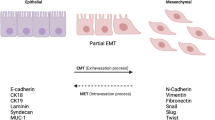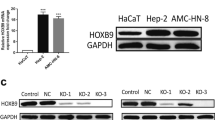Abstract
Invasion and metastasis are the major causes of death in patients with esophageal squamous cell carcinoma (ESCC). Recent studies have confirmed that SPARC/osteonectin, cwcv and kazal-like domains proteoglycan 1 (SPOCK1) plays multiple roles in cancer progression. This study aims to explore the clinical characteristics of SPOCK1 in ESCC and its roles in the migration and invasion of ESCC cell lines. In this study, the up-regulation of SPOCK1 expression was frequently detected in primary ESCC tumor tissues compared with those in non-tumor tissues, which was significantly associated with tumor invasion (p = 0.004) and distant metastasis (p = 0.010). SPOCK1 was expressed at higher level in TE13 cells as compared to the low malignant Eca109 and TE1 cells. Overexpression of SPOCK1 in Eca109 cells decreased the expressions of epithelial marker E-cadherin and ZO-1, while increased mesenchymal marker Vimentin and N-cadherin levels. After ectopic expression of SPOCK1, Eca109 cells exhibited a morphological change from an epithelial cobblestone phenotype to an elongated fibroblastic phenotype, concomitant with cytoskeletal rearrangements and increased migration and invasion, suggesting that EMT occurs. While silencing SPOCK1 in TE13 cells had the opposite effects. These results suggest that up-regulation of SPOCK1 in ESCC induces EMT, thus promotes migration and invasion in ESCC cells.






Similar content being viewed by others
References
Bradshaw AD, Sage EH (2001) SPARC, a matricellular protein that functions in cellular differentiation and tissue response to injury. J Clin Invest 107:1049–1054
Che Y, Luo A, Wang H, Qi J, Guo J, Liu Z (2006) The differential expression of SPARC in esophageal squamous cell carcinoma. Int J Mol Med 17:1027–1033
Chen WQ, Zheng RS, Zhang SW, Zeng HM, Zou XN (2014) The incidences and mortalities of major cancers in China, 2010. Chin J Cancer 33:402–405
Cifuentes-Diaz C et al (2000) Regulated expression of the proteoglycan SPOCK in the neuromuscular system. Mech Dev 94:277–282
Colin C et al (2006) Identification of genes differentially expressed in glioblastoma versus pilocytic astrocytoma using Suppression Subtractive Hybridization. Oncogene 25:2818–2826
Enzinger PC, Mayer RJ (2003) Esophageal cancer. N Engl J Med 349:2241–2252
Han P et al (2014) BVES inhibition triggers epithelial–mesenchymal transition in human hepatocellular carcinoma. Dig Dis Sci 59:992–1000
Hartmann U et al (2013) Testican-3: a brain-specific proteoglycan member of the BM-40/SPARC/osteonectin family. J Neurochem 125:399–409
Jemal A, Siegel R, Ward E, Hao Y, Xu J, Murray T, Thun MJ (2008) Cancer statistics, 2008. CA Cancer J Clin 58:71–96
Lee JM, Dedhar S, Kalluri R, Thompson EW (2006) The epithelial–mesenchymal transition: new insights in signaling, development, and disease. J Cell Biol 172:973–981
Li M et al (2013a) Effects of EHD2 interference on migration of esophageal squamous cell carcinoma. Med Oncol 30:396
Li Y et al (2013b) SPOCK1 is regulated by CHD1L and blocks apoptosis and promotes HCC cell invasiveness and metastasis in mice. Gastroenterology 144(179–191):e174
Lin Y et al (2013) Epidemiology of esophageal cancer in Japan and China. J Epidemiol 23:233–242
Liu J et al (2015) The histidine-rich calcium binding protein (HRC) promotes tumor metastasis in hepatocellular carcinoma and is upregulated by SATB1. Oncotarget 6:6811–6824
Luo A et al (2004) Discovery of Ca2+-relevant and differentiation-associated genes downregulated in esophageal squamous cell carcinoma using cDNA microarray. Oncogene 23:1291–1299
Miao L, Wang Y, Xia H, Yao C, Cai H, Song Y (2013) SPOCK1 is a novel transforming growth factor-beta target gene that regulates lung cancer cell epithelial–mesenchymal transition. Biochem Biophys Res Commun 440:792–797
Pennathur A, Gibson MK, Jobe BA, Luketich JD (2013) Oesophageal carcinoma. Lancet 381:400–412
Radisky DC (2005) Epithelial–mesenchymal transition. J Cell Sci 118:4325–4326
Remmele W, Stegner HE (1987) Recommendation for uniform definition of an immunoreactive score (IRS) for immunohistochemical estrogen receptor detection (ER-ICA) in breast cancer tissue. Pathologe 8:138–140
Shu YJ et al (2015) SPOCK1 as a potential cancer prognostic marker promotes the proliferation and metastasis of gallbladder cancer cells by activating the PI3 K/AKT pathway. Mol Cancer 14:12
Thiery JP, Acloque H, Huang RY, Nieto MA (2009) Epithelial–mesenchymal transitions in development and disease. Cell 139:871–890
Thompson EW, Newgreen DF, Tarin D (2005) Carcinoma invasion and metastasis: a role for epithelial–mesenchymal transition? Cancer Res 65:5991–5995 (discussion 5995)
Tu W et al (2012) Upregulation of SATB1 promotes tumor growth and metastasis in liver cancer. Liver Int 32:1064–1078
Wong FH et al (2009) Combination of microarray profiling and protein-protein interaction databases delineates the minimal discriminators as a metastasis network for esophageal squamous cell carcinoma. Int J Oncol 34:117–128
Yan W et al (2009) PI3 kinase/Akt signaling mediates epithelial–mesenchymal transition in hypoxic hepatocellular carcinoma cells. Biochem Biophys Res Commun 382:631–636
Yan W et al (2014) Netrin-1 induces epithelial–mesenchymal transition and promotes hepatocellular carcinoma invasiveness. Dig Dis Sci 59:1213–1221
Yang J, Weinberg RA (2008) Epithelial–mesenchymal transition: at the crossroads of development and tumor metastasis. Dev Cell 14:818–829
Zhang S et al (2014) Overexpression of leucine aminopeptidase 3 contributes to malignant development of human esophageal squamous cell carcinoma. J Mol Histol 45:283–292
Acknowledgments
This work was supported by the National Natural Science Foundation of China (Nos. 81270507, 81272657, 81472311, 81401992), the Fundamental Research Funds for the Central Universities (2014ZHYX020, 2014TS077), the Project sponsored by SRF for ROCS, SEM (2014-1685) and Hubei Province health and family planning scientific research project (WJ2015Q006).
Conflict of interest
The authors declare that they have no conflict of interest.
Ethical standard
All procedures performed in studies involving human participants were in accordance with the ethical standards of the Ethics Committee of the Tongji Hospital and with the 1964 Helsinki declaration and its later amendments or comparable ethical standards. This article does not contain any studies with animals performed by any of the authors.
Informed consent
Informed consent was obtained from all individual participants included in the study.
Author information
Authors and Affiliations
Corresponding author
Additional information
Xiaopeng Song and Ping Han have contributed equally to this work.
Rights and permissions
About this article
Cite this article
Song, X., Han, P., Liu, J. et al. Up-regulation of SPOCK1 induces epithelial–mesenchymal transition and promotes migration and invasion in esophageal squamous cell carcinoma. J Mol Hist 46, 347–356 (2015). https://doi.org/10.1007/s10735-015-9627-2
Received:
Accepted:
Published:
Issue Date:
DOI: https://doi.org/10.1007/s10735-015-9627-2




